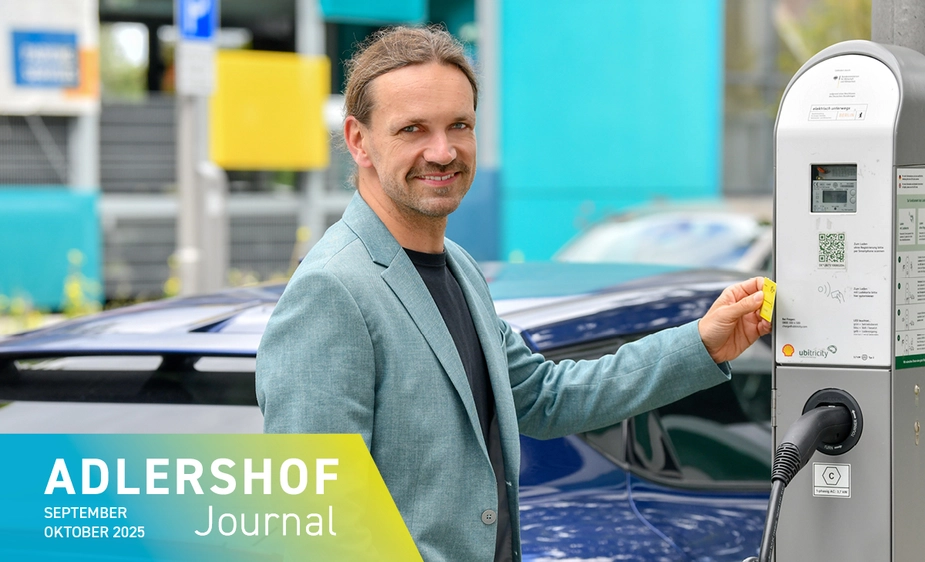In conversation with Oliver Arnhold
At Localiser, he plans charging infrastructure for electromobility
A spin off of the Reiner Lemoine Institute (RLI), electromobility and hydrogen expert Localiser describes itself today as the market leader in Germany when it comes to the planning of charging infrastructure. “We’ve been in business for seven years with a great team of 14 people working in 13 countries,” says Localiser’s Managing Director, Oliver Arnhold. “Four months ago, we moved to Wagner-Régeny-Straße 14 in Adlershof. The move has given us more space for creative collaboration and further growth.”
Adlershof Journal: How do you remain persistent when climate issues are being considered low priority?
Oliver Arnhold: This is indeed what we are seeing in politics and public discourse. Instead, the focus is moving towards a ‘resilient energy supply’ and increasing ‘international competition’. We believe that the measures necessary to address these issues will also be based on a robust, renewable energy system using electromobility, and that the establishment of a functioning hydrogen value chain will be just as important.
Why is Localiser needed for this?
We started carrying out location assessments and studies for charging infrastructure at RLI back in 2010. The process was complex and wasn’t scalable. At RLI and Localiser, we are looking to accelerate the energy and transport transition and ensure this is done as smartly and economically as possible. By founding Localiser, we have automated the planning process to find the best locations for charging infrastructure and have even standardised it with the German Institute for Standardisation (DIN). With our software, customers in Europe now analyse 20,000 locations per week and receive yield forecasts up to the year 2035. Our portfolio ranges from yield assessments for streetlamp chargers with up to 3.7kW to charging parks for electric lorries.
What would you like to say to those who are sceptical about e-mobility?
It’s understandable that they have doubts as there are so many myths and misconceptions going round. We rely on facts, “experience” challenges ourselves in the truest sense of the word and test the current charging infrastructure and electric vehicles domestically and abroad. Range anxiety, for example, is one of the classic concerns. Today, even small cars can travel 200 kilometres in winter and modern mid-range vehicles can realistically travel 300 to 400 kilometres, even on the motorway. Almost every electric vehicle can be charged to 80 percent of its capacity at a fast charging station in half an hour, and some new vehicles can be charged in just 15 minutes.
What about the batteries?
Battery production is particularly energy-intensive and requires raw materials, but research is making huge strides in reducing the use of materials and increasing recycling rates. When compared to the entire life cycle of a combustion engine, electric vehicles already perform significantly better, especially when they are powered by green electricity. Recently, a German vehicle manufacturer published the carbon footprint of its new model and results showed that the electric vehicle, charged with the European electricity mix, proved to be better than the comparable combustion engine after less than 30,000km.
Electric cars are also no more dangerous than combustion engines. Modern safety systems and rigorous testing ensure the safety of the batteries. Statistics show that electric cars do not catch fire any more than petrol or diesel cars.
The remaining important factor is cost-effectiveness. Charging vehicles at your own PV system or using them as company cars is an exceptionally attractive option, but electric vehicles can also offer advantages for private use and public charging.
How well is the Technology Park already equipped with charging points?
Things got off to an excellent start. In 2018, one of Europe’s first 800-volt fast chargers was installed here and there are now a substantial number of charging stations with various charging speeds. That said, the expansion of the charging infrastructure will be an ongoing task for the next few decades, as electric vehicles still account for less than 5 percent of the total number of vehicles on the road.
Who should get in touch with you for planning purposes?
Charging points can more or less be installed anywhere where we park vehicles. The spectrum is huge. Localiser helps with the planning in so-called publicly accessible spaces: at supermarkets, restaurants, hotels, sports and leisure facilities, car parks, at the roadside, and, of course, on motorways, main roads, and many other locations.
Full coverage charging infrastructure is particularly important in urban areas where people live but cannot charge their vehicles at their own wallboxes on private property. For companies, it’s also worthwhile to provide charging infrastructure in their car parks. Making these charging points accessible to the public during off-peak hours can also prove beneficial. In short, anyone who wants to make the best decision when it comes to placing and investing in multiple charging points is the right partner for us.
What is the hydrogen marketplace?
Our hydrogen marketplace is the first fully digital, web-based platform which connects producers and users of hydrogen across Germany and beyond. Our goal is to bring together organisations from the entire hydrogen value chain to enable the hydrogen economy to grow faster and more efficiently. There are currently more than 680 companies registered. It’s important to mention our matching function which automatically brings suitable partners together, thereby simplifying the planning and development of new projects quite significantly.
Peggy Mory for Adlershof Journal
